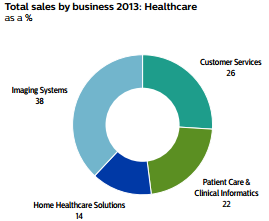
Operations management
运营管理
运营管理 Royal Philips is a Dutch company operating into three businesses namely healthcare, consumer lifestyle, and lighting. The company..
Executive Summary
Royal Philips is a Dutch company operating into three businesses namely healthcare, consumer lifestyle, and lighting. The company is well known for its innovation and producing new products and has research campuses in China, India, and Netherlands which are required to identify the needs of consumers along with providing concepts of new product development.
Philips follows a business creation process that defines the processes of new product development. Philips uses various software to facilitate in smoothening their operations include SAP and SAVO. The process management at Philips is well maintained as it works in delivering higher value to customers However,
Philips focuses so much on innovation that its focus on customers becomes low and is termed as product centric business. Lean management is followed by Philips and is termed as Six Sigma lean programs. Philips manages its capacity well with the help of research campuses that identify the demand of each market in each season.
However, as the demand is uncertain therefore to manage this uncertainty change demand is followed in which demand is changed each month.
译文:执行摘要 运营管理
Contents
- Introduction
- PART A
- i) Evaluation of existing operations functions of Philips
- Role of the operations manager
- ii) Process management and Process Chart of Philips
- iii) Lean management in Philips
- PART B
- Capacity management in Philips
- PART C
- Conclusion
- Recommendations
- References
译文:内容 运营管理
简介
甲部
i) 评估飞利浦现有的运营职能
运营经理的角色
ii) 飞利浦的流程管理和流程图表
iii) 飞利浦的精益管理
乙部
飞利浦的容量管理
C部分
结论
建议
参考文献
List of Figures
Figure 1: Total Sales 2013 of Philips Healthcare
Figure 2: Total Sales 2013 of Philips consumer lifestyle business
Figure 3: Total Sales 2013 of Philips lighting business
Figure 4: Business Creation Process
Figure 6: Philips Research results
Figure 7: Philips Research results
Figure 8: Philips Research results
Figure 11: Business improvement after lean processes in Philips
Figure 12: Traditional and Lean Company
Figure 13: Eight Areas of Lean Management of Philips
Figure 14: Lean manufacturing in Philips
Figure 15: Capacity Management
Figure 16: Improved Lives by Philips
译文:图表清单 运营管理
图 1:飞利浦医疗保健 2013 年的总销售额
图 2:飞利浦消费者生活方式业务 2013 年的总销售额
图 3:飞利浦照明业务 2013 年总销售额
图 4:业务创建过程
图 5:流程图
图 6:飞利浦研究结果
图 7:飞利浦研究结果
图 8:飞利浦研究结果
图 9:EFQM 模型
图 10:三重底线
图 11:飞利浦精益流程后的业务改进
图 12:传统和精益公司
图 13:飞利浦精益管理的八个领域
图 14:飞利浦的精益制造
图 15:容量管理
图 16:飞利浦改善生活
Introduction
As mentioned by Philips (2015a), Philips is a Dutch technology product development company focusing on improving the life of consumers throughout the world. It manufactures variety of products including Healthcare, consumer well being and lighting products. The healthcare business of Philips aims at improving patient care for patients of all age with its latest technology usage and variety of global solutions.
Philips health business revolves around Imaging Systems, Patient Care and Clinical Informatics products, Home Healthcare Solutions along with Healthcare Transformation Services.
译文:简介
正如飞利浦 (2015a) 所提到的,飞利浦是一家荷兰科技产品开发公司,专注于改善全球消费者的生活。 它生产各种产品,包括医疗保健、消费者福利和照明产品。 飞利浦的医疗保健业务旨在通过其最新的技术使用和各种全球解决方案为所有年龄段的患者改善患者护理。
飞利浦健康业务围绕成像系统、患者护理和临床信息学产品、家庭医疗保健解决方案以及医疗保健转型服务展开。

Figure 1: Total Sales 2013 of Philips Healthcare
(Source: Philips Annual report, 2013).
As stated by Philips (2015a), Philips consumer lifestyle business aims at improving the living standards of consumers through innovative technological means. Moreover, consumer lifestyle business of Philips connects with the consumer to understand their needs and wants in order to cater to them effectively. This business of Philips focuses of health and wellness products, personal care products and domestic appliances.
译文:图 1:飞利浦医疗保健 2013 年的总销售额 运营管理
(来源:飞利浦年度报告,2013 年)。
正如飞利浦(2015a)所说,飞利浦消费者生活方式业务旨在通过创新的技术手段提高消费者的生活水平。 此外,飞利浦的消费者生活方式业务与消费者建立联系,了解他们的需求和愿望,从而有效地迎合他们。 飞利浦的这项业务专注于健康和保健产品、个人护理产品和家用电器。
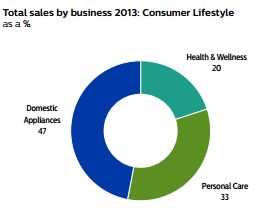
Figure 2: Total Sales 2013 of Philips consumer lifestyle business
(Source: Philips Annual report, 2013).
As indicated by Philips (2015a), Philips is one of the leading brand and recognized brand in lighting business due to experience of more than 100 years in these products along with innovative product development based on LED leadership. All lighting need of consumers are fulfilled by Philips as they have best solutions for homes, offices, Hotel, factories, restaurants and for public areas as well. Following figure shows the products of Philips in lighting business.
译文:图 2:飞利浦消费者生活方式业务 2013 年的总销售额 运营管理
(来源:飞利浦年度报告,2013 年)。
正如飞利浦 (2015a) 指出的那样,飞利浦是照明行业的领先品牌和公认品牌之一,因为在这些产品方面拥有 100 多年的经验以及基于 LED 领先地位的创新产品开发。 飞利浦可以满足消费者的所有照明需求,因为他们为家庭、办公室、酒店、工厂、餐厅和公共区域提供最佳解决方案。 下图显示了飞利浦在照明业务中的产品。
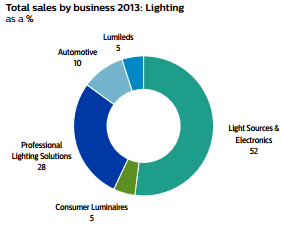
Figure 3: Total Sales 2013 of Philips lighting business
(Source: Philips Annual report, 2013).
According to Philips Annual report (2013), the reason for leadership position and success of all the business of Philips along with strong brand value is due to continuous innovation in each market through relationship with various academic and industrial partnerships. The business has variety of research and development campuses for development of innovative products in China,
India and Netherland. Philips (2015a) stated that Accelerate! is a program started in 2011 that is based on performance innovation along with journey of change. It aims at identifying the potential of the employees at Philips in order to produce innovative goods faster and better than that of competitors in order to sustain the leading positions of Philips.
In addition, as Philips is based on improving lives of consumers not only by products but also by its operations therefore sustainability is followed in each business of Philips.
The success of Philips is due to the well managed operations it has. The report is based on operations management of Philips and initiates with evaluation of existing operation functions with the organization along with the role of operations manager. The report further incorporates the process chart of Philips illustrating how customers are processed through operations with the organization.
Moreover, lean management is discussed along with its benefits for the organization. Managing capacity is one of the complicated parts of operations management due to uncertainty. Therefore managing capacity is discussed in detail. Finally, concrete conclusion and recommendations for Philips are given in the report.
译文:图 3:飞利浦照明业务 2013 年总销售额 运营管理
(来源:飞利浦年度报告,2013 年)。
根据飞利浦年度报告(2013 年),飞利浦所有业务的领导地位和成功以及强大的品牌价值的原因是通过与各种学术和行业合作伙伴关系在每个市场中不断创新。该业务在中国拥有各种研发园区,用于开发创新产品,
印度和荷兰。飞利浦 (2015a) 表示加速!是一项始于 2011 年的计划,该计划基于绩效创新和变革之旅。它旨在发掘飞利浦员工的潜力,以便比竞争对手更快、更好地生产创新产品,从而保持飞利浦的领先地位。
此外,由于飞利浦不仅通过产品改善消费者的生活,而且通过其运营来改善消费者的生活,因此飞利浦的每一项业务都遵循可持续性。
飞利浦的成功归功于其良好的运营管理。该报告基于飞利浦的运营管理,并开始评估组织的现有运营职能以及运营经理的角色。该报告进一步结合了飞利浦的流程图,说明了如何通过与组织的运营来处理客户。
此外,还讨论了精益管理及其对组织的好处。由于不确定性,管理能力是运营管理的复杂部分之一。因此,将详细讨论管理容量。最后,报告给出了飞利浦的具体结论和建议。
PART A
i) Evaluation of existing operations functions of Philips
According to Philips Research (2015), Philips is based on innovative solutions therefore the operations of Philips start from the research and development activity where the new innovative means, growing and changing needs and the ways to make consumers happy and to satisfy more of their needs are identified.
As given by Scheine (2013), the product development phase of Philips is known as business creation process and consists of the steps illustrated by the figure below.
译文:甲部
i) 评估飞利浦现有的运营职能
根据飞利浦研究(2015 年),飞利浦基于创新解决方案,因此飞利浦的运营始于研发活动,其中新的创新手段、不断增长和不断变化的需求以及让消费者满意并满足更多需求的方法 被识别。
正如 Scheine (2013) 所说,飞利浦的产品开发阶段被称为业务创建过程,由下图所示的步骤组成。

Figure 4: Business Creation Process
(Source: Scheine, 2013).
As mentioned by Scheine (2013), the business creation process starts with the strategic planning, the strategic planning involves all of the stakeholders as each one of them has some knowledge that the other does not even know about. For example, the retailer will know much better about the reason for changing consumer needs as compare to the manufacturer itself.
The involvement of all stakeholders helps in evaluation of a new product and the features that it needs to have. The portfolio management is based on reviewing the product portfolio of the company along with identifying the further improvement or discontinuation of the product. Moreover, Scheine (2013) adds that the sales cannibalization due to new product development is also identified.
译文:图 4:业务创建过程 运营管理
(来源:Scheine,2013 年)。
正如 Scheine (2013) 所提到的,业务创建过程始于战略规划,战略规划涉及所有利益相关者,因为他们每个人都有一些对方甚至不知道的知识。 例如,与制造商本身相比,零售商将更了解消费者需求变化的原因。
所有利益相关者的参与有助于评估新产品及其所需的功能。 投资组合管理基于审查公司的产品组合以及确定产品的进一步改进或停产。 此外,Scheine (2013) 补充说,还确定了由于新产品开发导致的销售蚕食。
The next step is based on the concept on the new product;
using insights of consumers and other stakeholders. The next step of application and solution is based on validation of proposition along with the feasibility of the product to be developed.
Once the concept is considered feasible then it moves towards manufacturing to comply with technical specifications, customer specific requirements and then toward product release. As mentioned by Mishra and Shah (2009), involving stakeholders lead to be a better product development and in most of the cases it guarantees success.
On contrast, Arnaboldi and Spiller (2011) argued that involving stakeholders can lead to information disclosure to competitors as the same stakeholder may be a part of the competitors group as well.
According to Philips (2015b), when the product to be developed is finalized then the company moves for to the acquisition of raw material. The company has moved a long from the traditional pattern of buying from suppliers. It has been maintaining good relationship with its suppliers along with including them in product development.
译文:下一步是基于新产品的概念; 运营管理
利用消费者和其他利益相关者的见解。下一步的应用和解决方案是基于提议的验证以及要开发的产品的可行性。
一旦概念被认为是可行的,它就会转向制造以符合技术规范、客户特定要求,然后转向产品发布。正如 Mishra 和 Shah (2009) 所提到的,让利益相关者参与会导致更好的产品开发,并且在大多数情况下它可以保证成功。
相比之下,Arnaboldi 和 Spiller (2011) 认为,让利益相关者参与可能会导致向竞争对手披露信息,因为同一利益相关者也可能是竞争对手群体的一部分。
根据飞利浦 (2015b) 的说法,当要开发的产品最终确定后,公司就会开始采购原材料。该公司已经摆脱了从供应商处采购的传统模式。它一直与供应商保持良好关系,并将他们纳入产品开发。
The strategies of Philips are standardized therefore same kind of relationship is followed in all parts of the world.
The reason for maintaining good relationship is due to the changing expectations of consumers for electronic industry. Customers appreciate those electronic companies that are high on innovation and low on lead times.
In order to increase the level of innovation and to reduce the lead time, strong relationship with each supplier is created. A very small amount of raw material is manufactured by Philips and almost 90% of the raw material is acquired through outsourcing and from suppliers that have a long term relationship with Philips. As mentioned by Ghijsen,
Semeijn and Ernstson (2010), a strong relationship between the manufacturer and the supplier leads to competitive edge for both of them as their association leads to higher profits and shorter lead times along with catering to quality aspect of the product well.
译文:飞利浦的战略是标准化的,因此世界各地都遵循同样的关系。 运营管理
保持良好关系的原因是消费者对电子行业的期望不断变化。 客户欣赏那些创新高、交货期短的电子公司。
为了提高创新水平并缩短交货时间,与每个供应商建立了牢固的关系。 飞利浦生产极少量的原材料,几乎 90% 的原材料是通过外包和从与飞利浦有长期合作关系的供应商处获得的。 正如 Ghijsen 所提到的,
Semeijn 和 Ernstson (2010),制造商和供应商之间的牢固关系为他们双方带来了竞争优势,因为他们的关联导致更高的利润和更短的交货时间以及很好地迎合产品的质量方面。
On contrast, Nair
Narasimhan and Bendoly (2011) argued that relationship with suppliers can lead to high bargaining power of suppliers as sensitive information is being shared by the manufacturer with the supplier therefore the switching cost of the manufacturer may go low. This result is growing demands for the suppliers end.
As given by Goodwin (2000), there was a paradigm shift in Philips and e procurement was adapted. The aim of this e procurement system was to reduce cost by 8%. However, only 3% was saved as an issue of unawareness within employees prevailed regarding placing orders through it. According to the SAVO Group (2012),
SAVO is a productivity software solution used by Philips in their operations to reduce their time utilized and to increase the productivity of the business.
译文:相比之下,奈尔
Narasimhan 和 Bendoly (2011) 认为,与供应商的关系可以导致供应商的高议价能力,因为制造商与供应商共享敏感信息,因此制造商的转换成本可能会降低。 这个结果是供应商端日益增长的需求。
正如 Goodwin (2000) 所指出的,飞利浦发生了范式转变,电子采购也进行了调整。 该电子采购系统的目标是将成本降低 8%。 然而,由于员工普遍存在对通过它下订单时不了解的问题,因此只有 3% 的人得救。 根据 SAVO 集团 (2012),
SAVO 是飞利浦在其运营中使用的生产力软件解决方案,以减少他们的时间利用并提高业务生产力。
As Philips believes in one strategy implemented all over the globe therefore the need for equal access to information,
Technology, training and other tools for sales team are significant. As Philips is into a lot of acquisitions therefore connecting to employees of all organization is essential and this need is served by SAVO. SAVO provides a platform to connect and train all employees throughout the globe at a single timing resulting in solving the issue of e procurement and achieving desired results.
Therefore, Philips does not need to wait for face to face interactions and in maintaining follow-ups with employees in other market for scheduling the training. In addition, knowledge and information sharing with the stakeholders is easy by the use of this solution.
Consumers are searching and adapting to products developed by Philips, in addition, they are clicking on the information regularly and are actually giving their views of the knowledge and information shared by the company. As mentioned by Stock and Zacharias (2011), the technology industry is into innovation along with catering higher needs of consumers.
The innovative need can be catered by polishing the skills of employees and that is possible by trainings at the global level to enhance the creativity and inventive skills of employees. On contrast, Buchel, Nieminen, Armbruster-Domeyer and Denison (2013) argued that involving stakeholders and consumers can lead to higher innovative products as compare to involving employees only.
译文:由于飞利浦相信一种在全球实施的战略,因此需要平等地获取信息,运营管理
销售团队的技术、培训和其他工具非常重要。由于飞利浦正在进行大量收购,因此与所有组织的员工建立联系至关重要,而 SAVO 满足了这一需求。 SAVO 提供了一个平台,可以在同一时间连接和培训全球所有员工,从而解决电子采购问题并实现预期结果。
因此,飞利浦无需等待面对面的互动以及与其他市场的员工进行跟进以安排培训。此外,通过使用此解决方案,可以轻松与利益相关者共享知识和信息。
消费者搜索和适应飞利浦开发的产品,此外,他们经常点击信息,实际上是对公司共享的知识和信息发表自己的看法。正如 Stock 和 Zacharias(2011 年)所提到的,技术行业在满足消费者更高需求的同时也在进行创新。
可以通过提高员工的技能来满足创新需求,而这可以通过在全球范围内进行培训来提高员工的创造力和创造性技能来满足。相比之下,Buchel、Nieminen、Armbruster-Domeyer 和 Denison(2013 年)认为,与仅让员工参与相比,让利益相关者和消费者参与可以产生更高的创新产品。
Role of the operations manager
An operational manager plays a significant role in the organization. The operational manager requires variety of skills and knowledge in order to handle the operations of the organization well. As given by Karsten,
Keulen, Kroeze and Peters (2009), the operation manager at Philips is different for each of the business but the roles they follow are quite similar as they are required to manage resources to achieve substantial operations.
Moreover, they planned and manage the operations well through efficient human resource usage. They set the goals and smart objectives for the operations of Philips and ensure that every employee follows the right path to achieve them. The education level and experience level of managers is high that is the reason why they have a bird eye view over the operations of Philips.
As mentioned by Langabeer (2008), communication skills and convincing skills are essential for an operations manager in order to handle the employees well. On contrast, Brown, Bessant and Lamming (2013) argued that financial overview is essential activity of operational manager in order to conduct the cost and benefit analysis for the business and to ensure that the resources are efficiently utilized. Longoni,
Golini and Cagliano (2014) stated that performance management and technology selection also add to the responsibilities of an operation manager.
运营经理的角色 运营管理
运营经理在组织中扮演着重要的角色。运营经理需要各种技能和知识才能很好地处理组织的运营。正如 Karsten 给出的那样,
飞利浦的运营经理 Keulen、Kroeze 和 Peters(2009 年)对每个企业来说都是不同的,但他们所扮演的角色非常相似,因为他们需要管理资源以实现实质性的运营。
此外,他们通过有效地使用人力资源来很好地计划和管理运营。他们为飞利浦的运营设定目标和明智的目标,并确保每位员工都遵循正确的道路来实现这些目标。管理人员的教育水平和经验水平高,这就是他们对飞利浦的运营有一个鸟瞰的原因。
正如 Langabeer (2008) 所提到的,沟通技巧和说服技巧对于运营经理来说是必不可少的,以便很好地处理员工。相比之下,Brown、Bessant 和 Lamming(2013 年)认为,财务概览是运营经理进行业务成本和收益分析并确保资源得到有效利用的基本活动。隆尼,
Golini 和 Cagliano (2014) 指出,绩效管理和技术选择也增加了运营经理的职责。
ii) Process management and Process Chart of Philips
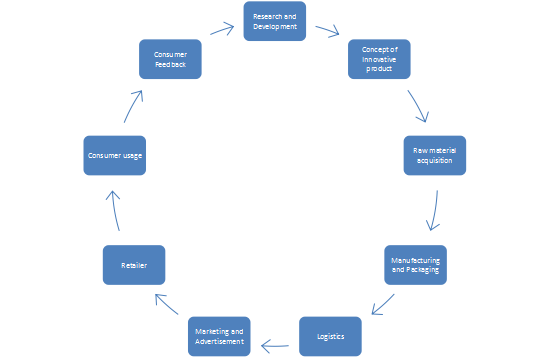
Figure 5: Process Chart
The process chart that shows the flow of how customers are being catered by Philips is indicated by the figure given above. The process starts with research and development that identifies the changing consumer needs along with the demand of that product in the market.
Philips Annual report (2013) presented that consumer’s needs in technological industry is different in each market therefore products are to be different according to the change in internal and external environment of each market. In accordance to this view, the research and development of Philips is based in three different markets of the globe including Netherlands,
China and India. Each research and development campus identifies the need of different markets in order to cater consumers in global markets effectively with their healthcare, lighting and well being products. As mentioned by Bush (2011), the lighting products required for European market is different from that of Asian market therefore the products developed for each market are also different.
However, Philips Annual report (2013) stated that the main strategy of Philips that is based on increasing consumer value and developing energy efficient products is standardized in each market. This standardized strategy serves as competitive edge for Philips. The research department of Philips identified that the aging population is growing thus shows that the demand of healthcare products will increase in the coming years.
Moreover, well being of people around the world shows that they need products continuously in order to maintain their well being. In addition, the demand for energy efficient consumption is also expanding and is identified by Philips in order to mange capacity and demand along with providing innovative solutions.
译文:图 5:流程图 运营管理
上图显示了显示飞利浦如何为客户提供服务的流程的流程图。该过程从研究和开发开始,以确定不断变化的消费者需求以及市场对该产品的需求。
飞利浦年报(2013)提出,每个市场的消费者对科技行业的需求是不同的,因此产品会根据每个市场内外环境的变化而有所不同。按照这种观点,飞利浦的研发立足于全球三个不同的市场,包括荷兰、
中国和印度。每个研发园区都确定了不同市场的需求,以便通过其医疗保健、照明和保健产品有效地满足全球市场的消费者需求。 Bush (2011) 提到,欧洲市场所需的照明产品与亚洲市场不同,因此针对每个市场开发的产品也不同。
然而,飞利浦年报(2013)指出,飞利浦以增加消费者价值和开发节能产品为基础的主要战略在每个市场都是标准化的。这种标准化战略是飞利浦的竞争优势。飞利浦的研究部门发现人口老龄化正在加剧,这表明未来几年保健产品的需求将会增加。
此外,世界各地人们的幸福感表明,他们不断需要产品来维持他们的幸福感。此外,对节能消费的需求也在不断扩大,飞利浦确定了这一需求,以便在提供创新解决方案的同时管理产能和需求。
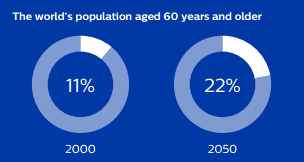
Figure 6: Philips Research results
(Source: Philips Annual report, 2013)
译文:图 6:飞利浦研究结果 运营管理
(来源:飞利浦年度报告,2013)
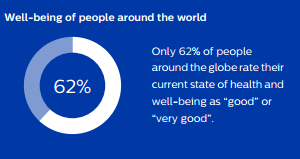
Figure 7: Philips Research results
(Source: Philips Annual report, 2013)
译文:图 7:飞利浦研究结果
(来源:飞利浦年度报告,2013)
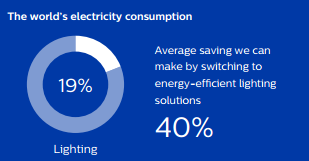
Figure 8: Philips Research results
(Source: Philips Annual report, 2013)
As mentioned by Scheine (2013), the next step of concept of innovative product is developed and approved by all the internal stakeholders as each one can provide relevant information on selling, technology usage and capacity utilization. Once the concept is considered competitive and is approved, then a plan is developed which helps in identifying the steps that the product development will take place in.
According to Philips (2011), raw material procurement is the initial part of the process mapping and strong relationship are developed with the suppliers in order to reduce the lead times and cost of supplies. In 2011, due to economy recovery, the supplies were short and prices of those supplies were increased due to shortage.
However, this did not affect Philips much as they were able to negotiate with the suppliers well along with delaying price increase due to the strong relationship the company has with its suppliers.
图 8:飞利浦研究结果 运营管理
As stated by Philips (2013), the next step of the flow is product manufacturing and packaging.
Manufacturing of Philips are increasing in Asian economies due to technology from India and cheap factor of production in Asian economies.
However, most of the activities of Philips are outsourced due to better quality produced when outsourced rather then producing it internally. However, the manufacturing is also based on the needs of consumers and support of supply chain members. All of the activities of Philips are working on green practices even the next logistics activity of Philips is based on green practices and works on minimizing carbon emissions.
Various programs are operating to reduce logistics emissions and Philips is following freight consolidation and deconsolidation to ensure that no energy to maximize capacity on both sides to reduce empty kilometres that effect the environment.
As mentioned by Fineberg (2014), Marketing and advertising of the products of Philips is done through print advertising and through e marketing techniques to attract many consumers along with reducing the cost. It mostly caters to business consumers along with few of other consumers therefore it advertises through interactive advertisements, short stories on social media regarding the innovative aspect of the company.
The effect that innovation has on the consumer’s life is illustrated by the advertising efforts. The next step of the process includes retailers; the products of Philips are available at official Philips stores with half of the products available with the retailers.
译文:正如飞利浦 (2013) 所说,流程的下一步是产品制造和包装。 运营管理
由于来自印度的技术和亚洲经济体的廉价生产要素,飞利浦的制造在亚洲经济体中正在增加。
然而,飞利浦的大部分活动都是外包的,因为外包时生产的质量更好,而不是内部生产。但是,制造也是基于消费者的需求和供应链成员的支持。飞利浦的所有活动都致力于绿色实践,即使飞利浦的下一个物流活动也是基于绿色实践并致力于最大限度地减少碳排放。
各种计划正在运行以减少物流排放,飞利浦正在跟踪货运合并和拆箱,以确保没有能源最大限度地提高双方的容量,以减少影响环境的空公里。
正如 Fineberg (2014) 所提到的,飞利浦产品的营销和广告是通过印刷广告和电子营销技术来完成的,以在降低成本的同时吸引更多消费者。它主要迎合商业消费者以及少数其他消费者,因此它通过互动广告、社交媒体上关于公司创新方面的短篇小说来做广告。
广告努力说明了创新对消费者生活的影响。该流程的下一步包括零售商;飞利浦的产品在飞利浦官方商店有售,其中一半的产品在零售商处有售。
As mentioned by Philips (2013)
The retailers are required to follow the ethical regulations and policies of the market it operates in order to carry products of Philips. The products are available at variety of stores in each market in order to make the product available to all consumers easily and with convenience. Next is the stage where consumer buys and uses the product in order to identify and analyze whether the product is able to meet their needs effectively.
If the needs of consumers and perception are met by the products of Philips thus results in loyal customer, repeat purchase and increase in brand equity. However, if the need of consumer is not catered well, then consumers can suggest or put forward their complaints regarding the product or the need.
Philips works effectively on complains and suggestions given by the customers as they serve as the development for new product for the company. According to SAVO Group (2012), SAVO is adapted by Philips in order to provide information to consumers regarding various innovative products through articles and stories.
Moreover, SAP (2013) mentioned that SAP is also adapted in Philips in promoting innovation through customer relationship management (CRM) programs which facilitates in managing customer information from initial request of information seeking to shipping and invoicing part of the process.
In addition, this helped in increasing customer satisfaction as their queries and problems were solved instantly along with forecasting demand on the basis of information of consumers. Moreover, SAP helps in faster order delivery and this helps in increasing value delivered to consumer.
译文:正如飞利浦 (2013) 所提到的 运营管理
零售商必须遵守其经营的市场的道德法规和政策,才能销售飞利浦的产品。这些产品在每个市场的各种商店都有售,以便让所有消费者都能轻松方便地获得产品。接下来是消费者购买和使用产品的阶段,以识别和分析产品是否能够有效满足他们的需求。
如果飞利浦的产品满足消费者的需求和感知,从而导致忠诚的客户、重复购买和品牌资产的增加。但是,如果消费者的需求没有得到很好的满足,消费者可以对产品或需求提出建议或投诉。
飞利浦有效地处理客户提出的投诉和建议,并将其作为公司新产品的开发。据 SAVO Group (2012) 称,SAVO 由飞利浦改编,目的是通过文章和故事向消费者提供有关各种创新产品的信息。
此外,SAP(2013 年)提到,SAP 也适用于飞利浦,通过客户关系管理 (CRM) 程序促进创新,该程序有助于管理客户信息,从最初的信息寻求到运输和发票部分流程。
此外,这有助于提高客户满意度,因为他们的疑问和问题得到了即时解决,并根据消费者的信息预测了需求。此外,SAP 有助于更快地交付订单,这有助于增加交付给消费者的价值。
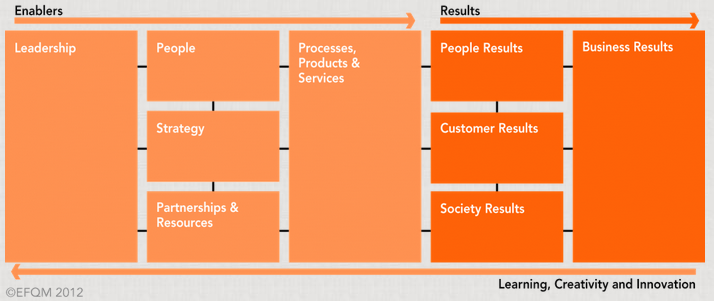
Figure 9: EFQM Model
(Source: EFQM, 2015)
According to Philips (2015c), In order to create quality and improvement in its operations, Philips is a member of EFQM and follows the EFQM model. As stated by EFQM (2015), the model is based on creating leadership in terms of the people, strategy, partnership and resources. The people are the employees whereas the strategy is the overall strategy of the company.
Moreover, developing better association with suppliers and other supply chain members will lead to leadership in relationship as well. This leadership will result in better processes, products and services developed.
The overall enablers act will give overwhelming results in terms of satisfied people, customers and society and satisfaction of stakeholders will result in better business results in terms of sales, profitability, brand image and brand awareness. Moreover, learning, creativity and innovation can be attained from these results to make the internal operations of the company better.
As stated by Madison (2005), in process management, one of the main aspect is to manage the inventory well and to ensure that the flow of inventory is efficient and on time. It can be achieved by supplier assistance, employing inventory control personnel and by tracking the inventory. Software can do well in these aspects to ensure that the inventory is well maintained. On contrast,
Lamb, Hair and McDaniel (2008) argued that the inventory of Philips is managed well but the just in time approach is not being followed by any of its business.
译文:图 9:EFQM 模型 运营管理
(来源:EFQM,2015)
根据飞利浦 (2015c) 的说法,为了在运营中创造质量和改进,飞利浦是 EFQM 的成员,并遵循 EFQM 模式。正如 EFQM(2015 年)所述,该模型基于在人员、战略、伙伴关系和资源方面建立领导力。人是员工,战略是公司的整体战略。
此外,与供应商和其他供应链成员建立更好的联系也将导致领导关系。这种领导将导致更好的流程、产品和服务的开发。
整体推动者法案将在人们、客户和社会满意度方面产生压倒性的结果,利益相关者的满意度将在销售、盈利能力、品牌形象和品牌知名度方面带来更好的业务成果。而且,可以从这些结果中获得学习、创造和创新,从而使公司的内部运作更好。
正如 Madison (2005) 所说,在流程管理中,主要方面之一是做好库存管理,确保库存流动高效、准时。这可以通过供应商协助、雇用库存控制人员和跟踪库存来实现。软件可以在这些方面做得很好,以确保库存得到很好的维护。相比之下,
Lamb、Hair 和 McDaniel (2008) 认为飞利浦的库存管理良好,但其任何业务都没有遵循及时方法。
According to Philips (2015d)
all the businesses at Philips ensure that the inventory management is an integral part of the business therefore they use Xper Information Management Inventory Coordinator to facilitate them in this aspect. It is connected with other functional software in order to certify that the information is accessible to all functions along with reducing the chances of redundant information.
In addition, the plans and actiivites are scheduled well as if one activity is late then this can cause time delay in all following activities as well..
译文:根据飞利浦 (2015d)
飞利浦的所有业务都确保库存管理是业务的一个组成部分,因此他们使用 Xper 信息管理库存协调器在这方面为他们提供便利。 它与其他功能软件连接,以证明所有功能都可以访问信息,同时减少冗余信息的机会。
此外,计划和活动安排得很好,如果一项活动迟到,那么这也会导致所有后续活动的时间延迟。
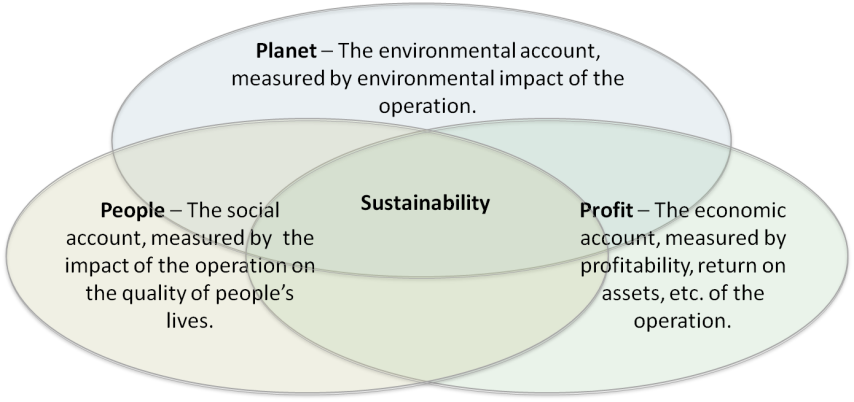
Figure 10: Triple Bottom Line
(Source: Archel, Fernandez and Larrinaga, 2008)
According to Archel, Fernandez and Larrinaga (2008), Operations in organizations are required to be planned well in order to achieve sustainability by triple bottom line. The operations can affect the planet by recycling materials, reducing energy consumption, reducing waste materials and carbon emissions along with lowering the impact of process failure on the environment.
The people aspect is catered through operations by providing customer safety, employment at the location of operations, employee safety procedures and non exploitation of employees. If operations are catering well in achieving sustainability then the profits will also increase for the firm resulting in benefit for each stakeholder. As stated by Denning (2011),
The aim of Philips is to maintain its profits along with beating the competition but is giving low emphasis on creating customer pleasure. In addition, Philips is divesting its businesses that are not profitable but Philips should hold on with the important businesses and should make them grow by working on it.
This shows that the operations of Philips are green and aim at reducing impact on environment along with adding to the profits but the operations are not working for satisfying customers and is not playing good in terms of sustainability.
译文:图 10:三重底线 运营管理
(资料来源:Archel、Fernandez 和 Larrinaga,2008 年)
根据 Archel、Fernandez 和 Larrinaga(2008 年)的说法,为了通过三重底线实现可持续性,需要很好地规划组织中的运营。这些操作可以通过回收材料、减少能源消耗、减少废料和碳排放以及降低过程故障对环境的影响来影响地球。
人员方面通过运营提供客户安全、运营地点的就业、员工安全程序和不剥削员工来满足。如果运营在实现可持续性方面做得很好,那么公司的利润也会增加,从而为每个利益相关者带来好处。正如 Denning (2011) 所说,
飞利浦的目标是在击败竞争对手的同时保持利润,但不太重视创造客户的乐趣。此外,飞利浦正在剥离其不盈利的业务,但飞利浦应该坚持重要的业务,并通过努力使它们成长。
这表明飞利浦的运营是绿色的,旨在减少对环境的影响并增加利润,但这些运营并未满足客户的需求,在可持续性方面也没有发挥作用。
iii) Lean management in Philips
As mentioned by Philips (2015c), the Royal Philips used to apply Six Sigma as improvement tools for all of its business till 2008. As mentioned by Antony (2006), Six Sigma is used for improving the quality of process and product by reducing chances of errors of process. It is also based on identifying and analyzing the reasons for these errors.
Moreover, each process of Six Sigma identifies the errors that are occurring or can occur along with steps that can help in eliminating these errors without affecting the process much. According to Schroeder, Linderman,
Liedtke and Choo (2008), Six Sigma consists of statistical calculations and a business is considered to be good when the value of Six Sigma for its process is 99.99% that denotes that the products and processes are error free. However, Ede (2009) stated that in 2008, Philips realized that lean management tools are also to be added in order to be innovative along with operating through efficient and quality business processes.
The aim to add lean manufacturing was to reduce waste and to create higher value for consumers. The quality aspect of Philips is known as Six Sigma lean programs which use both Six Sigma and lean principles in order to sustain its position in terms of quality in the industry.
译文:iii) 飞利浦的精益管理 运营管理
正如飞利浦 (2015c) 所提到的,皇家飞利浦过去一直将六西格码作为其所有业务的改进工具,直到 2008 年。 正如安东尼 (2006) 所提到的,六西格码用于通过减少机会来提高过程和产品的质量过程的错误。它还基于识别和分析这些错误的原因。
此外,六西格码的每个过程都会识别正在发生或可能发生的错误以及有助于消除这些错误而不会对过程产生太大影响的步骤。根据施罗德和林德曼的说法,
Liedtke 和 Choo (2008),六西格码由统计计算组成,当六西格码对其流程的价值为 99.99% 时,企业被认为是好的,这表示产品和流程没有错误。然而,Ede (2009) 表示,在 2008 年,飞利浦意识到还需要添加精益管理工具,以便在通过高效和优质的业务流程运营的同时进行创新。
增加精益生产的目的是减少浪费并为消费者创造更高的价值。飞利浦的质量方面被称为六西格码精益计划,该计划同时使用六西格码和精益原则,以保持其在行业质量方面的地位。
In each department of the business
one master black belt was hired in order to train the employees and to work towards lean processes of the business. As stated by Furterer (2009), the Master Black belt is a leader that works on DMAIC project. DMAIC is a tool used for quality management and stands for define, measure, analyze, improve and control in the lean processes.
According to Emiliani (2006), Lean management is based on identifying the waste and errors in each process to reduce the cost along with the impact on the environment resulting in higher value for the customers. As mentioned by Ede (2009), In Philips, instead of DMAIC, MEDIC was followed which stands for Map, Explore, define, implement and control.
However, in 2008, it was decided that each business will be responsible for its own quality improvement programs.
According to Ede (2010), the focus on improvement tools increased and moved from merely cost reduction to adding value. Value stream mapping was applied in stocking area to reduce the stock along with proper aligning and placement of each product.
Currently, there are more than 80 black belt masters in consumer lifestyle business of Philips that continuously work at reducing waste and errors along with efficient uses of resources. Even the research and development department of Philips works not only to produce plans for innovative products but the complete supply chain and value adding process of the product that aimed at lean processes.
译文:在业务的每个部门
聘请了一名黑带大师来培训员工并努力实现业务的精益流程。正如 Furterer (2009) 所说,黑带大师是从事 DMAIC 项目的领导者。 DMAIC 是一种用于质量管理的工具,代表精益流程中的定义、测量、分析、改进和控制。
根据 Emiliani (2006) 的说法,精益管理基于识别每个过程中的浪费和错误,以降低成本以及对环境的影响,从而为客户带来更高的价值。正如 Ede (2009) 所提到的,在飞利浦,不是 DMAIC,而是遵循 MEDIC,它代表地图、探索、定义、实施和控制。
然而,在 2008 年,决定每个企业将负责自己的质量改进计划。
根据 Ede (2010) 的说法,对改进工具的关注增加并从单纯的降低成本转向增加价值。价值流图应用于库存区域以减少库存以及每个产品的正确对齐和放置。
目前,飞利浦的消费者生活方式业务有80多位黑带大师,他们不断致力于减少浪费和错误以及有效利用资源。即使是飞利浦的研发部门,不仅要制定创新产品计划,还要制定针对精益流程的完整供应链和产品增值流程。
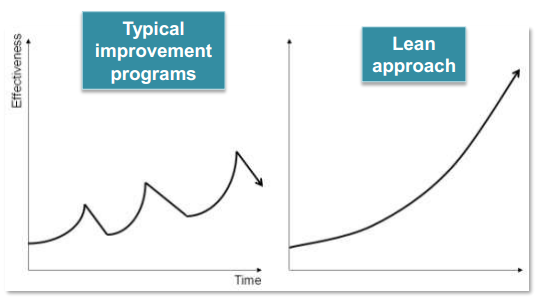
Figure 11: Business improvement after lean processes in Philips
(Source: Mil, 2010)
The above figure given by Mil (2010) shows that after implementation of lean approach in Philips, the improvement of the business has gone up with respect to time. It is due to lean product development that one factory in Philips Netherlands achieved double projects with approximately the same cost.
译文:图 11:飞利浦精益流程后的业务改进 运营管理
(资料来源:密尔,2010)
Mil (2010) 给出的上图显示,在飞利浦实施精益方法后,业务的改善随着时间的推移而上升。 正是由于精益产品开发,飞利浦荷兰的一家工厂以大致相同的成本实现了双重项目。
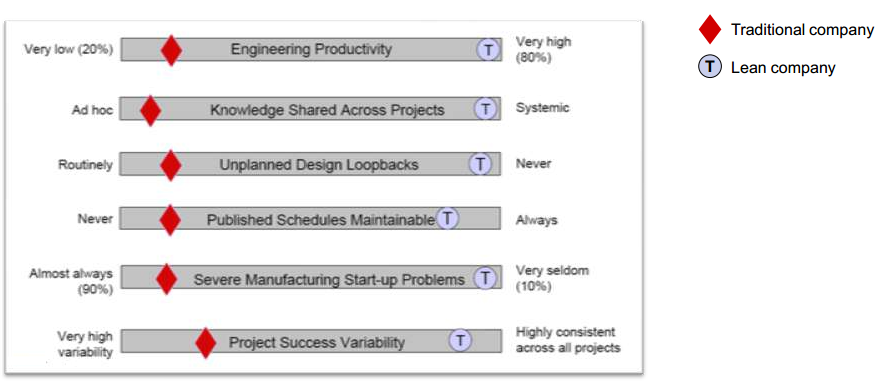
Figure 12: Traditional and Lean Company
(Source: Mil, 2010)
The figure above given by Mil (2010) presents that the change between a company following traditional practices and the company following lean practices. This made Philips realize the need for moving to lean processes. The engineering productivity of lean company is high at 80% as compare to 20% of traditional company.
Moreover, in lean processes, the knowledge sharing is systematic and unplanned design loopbacks are restricted. The published schedule maintenance and project success sustainability is high in lean processes. As Philips is an innovative company therefore the need of quick but factual information is essential along with proper means of information sharing therefore lean processes were inculcated in the functions of Philips.
In addition, Philip does not want to waste the time of people for information and engineers waiting for decisions due to lack of information. Moreover, the company wanted to have reduction in over processing, inventory, over production, useless processes and operations as these were wastage for the business therefore, Lean processes were adapted.
译文:图 12:传统和精益公司 运营管理
(资料来源:密尔,2010)
Mil (2010) 给出的上图显示了遵循传统实践的公司和遵循精益实践的公司之间的变化。这让飞利浦意识到需要转向精益流程。精益公司的工程生产率高达 80%,而传统公司的工程生产率仅为 20%。
此外,在精益流程中,知识共享是系统的,计划外的设计环回受到限制。公布的进度维护和项目成功可持续性在精益流程中很高。由于飞利浦是一家创新型公司,因此需要快速但真实的信息以及适当的信息共享方式是必不可少的,因此精益流程被灌输到飞利浦的职能中。
此外,Philip 不想浪费人们获取信息的时间和工程师因缺乏信息而等待决策的时间。此外,该公司希望减少过度加工、库存、过度生产、无用的流程和运营,因为这些对业务来说是浪费,因此调整了精益流程。
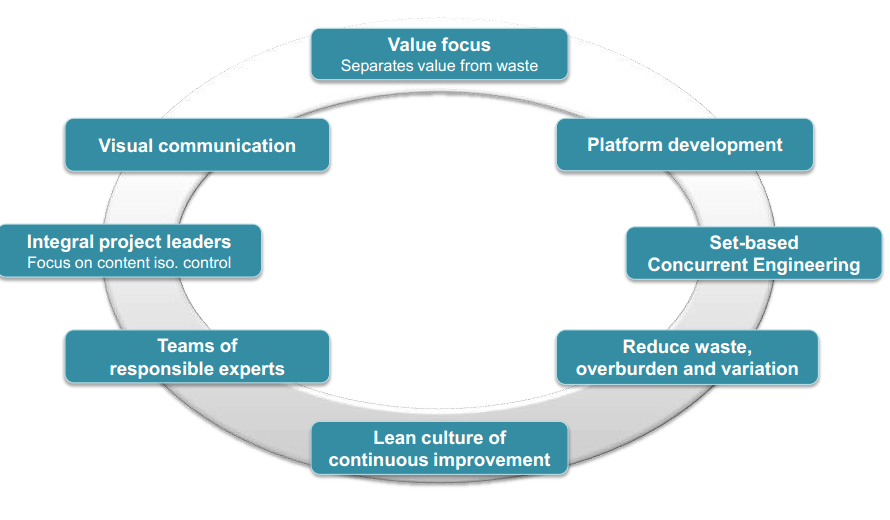
Figure 13: Eight Areas of Lean Management of Philips
(Source: Mil, 2010)
The figure above given by Mil (2010) shows the eight areas that were focused to inculcate lean management in Philips. The areas include value focus, platform development, set based concurrent engineering, reducing waste, overburden and variation, lean culture of continuous improvement, teams of responsible experts, integral project leaders and visual communication with can facilitate effective implementation of lean processes.
译文:图 13:飞利浦精益管理的八个领域 运营管理
(资料来源:密尔,2010)
Mil (2010) 给出的上图显示了飞利浦专注于灌输精益管理的八个领域。 这些领域包括价值聚焦、平台开发、基于集合的并行工程、减少浪费、负担和变化、持续改进的精益文化、负责任的专家团队、完整的项目领导和可视化沟通,可以促进精益流程的有效实施。
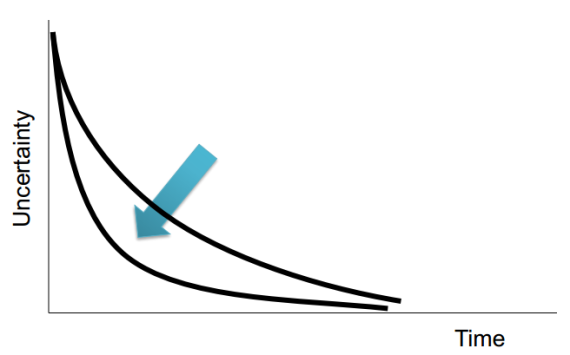
Figure 14: Lean manufacturing in Philips
(Source: Mil, 2010)
The above figure given by Mil (2010) illustrates that implementation of Lean manufacturing in Philips reduces the uncertainty and time of a project as the curve lowers as compare to the other curve that denotes time and uncertainty before lean processes. Lowering time and uncertainty is possible due to lowering lead time, quick product cycle along with fast prototyping.
According to Invistics (2006), the Lean manufacturing is not much adapted in the pharmaceutical company due to the fact that the complexities in manufacturing medicines is high along with the different challenges occurrence in its manufacturing plant as compare to other production plants. Disadvantages of not adapting to lean manufacturing include inability to reduce cost due to various waste activities throughout the supply chain.
As given by Yang, Choi, Park, Suh, and Chae (2007), Samsung follows Six Sigma approach and is not moving towards lean processes. This is due to the fact that Samsung aims at improving processes to achieve better productivity and results but does not aims at reducing wastages. The wastages are not reduced nor is the environment being beneficial in this aspect.
On contrast, Toyota follows Lean manufacturing system and is benefited by reducing waste, increasing value delivered to the customers along with minimizing costs. As mentioned by Ford, Williams Spencer, McCammon, Khoury, Sampson and Lee (2012), Toyota was pioneer in implementing lean processes and is highly benefited by it as compare to U.S. car manufacturer who are high on wastages and inefficient utilization of resources.
图 14:飞利浦的精益制造
(资料来源:密尔,2010) Mil (2010) 给出的上图表明,飞利浦精益制造的实施降低了项目的不确定性和时间,因为与表示精益流程之前的时间和不确定性的另一条曲线相比,曲线较低。由于缩短交货时间、缩短产品周期以及快速原型设计,因此可以减少时间和不确定性。 根据 Invistics (2006) 的说法,精益制造在制药公司中不太适用,因为与其他生产工厂相比,制造药品的复杂性很高,并且其制造工厂面临着不同的挑战。不适应精益制造的缺点包括由于整个供应链中的各种浪费活动而无法降低成本。 正如 Yang、Choi、Park、Suh 和 Chae(2007 年)所指出的,三星遵循 6 Sigma 方法并且没有转向精益流程。这是因为三星旨在改进流程以实现更好的生产力和结果,但并非旨在减少浪费。浪费没有减少,环境在这方面也没有好处。 相比之下,丰田遵循精益制造系统,并通过减少浪费、增加交付给客户的价值以及最大限度地降低成本而受益。正如 Ford、Williams Spencer、McCammon、Khoury、Sampson 和 Lee(2012 年)所提到的,丰田是实施精益流程的先驱,与高浪费和资源利用效率低下的美国汽车制造商相比,丰田从中受益匪浅。
PART B
Capacity management in Philips
According to Dugmore (2006), Capacity management is defined as the extent to which a company’s resources are able to produce particular amount of output in a certain time frame. It identifies the limit of an organizations’ factors of production can contribute to get the required amount of results. The organization resources includes skills and number of labour force along with managerial employees,
The land used for production and manufacturing, technology machinery, financial resources, intellectual property rights, inventory and various other resources without which the production is not possible. As mentioned by Stevenson and Hojati (2007), the product is required to meet the demand of the market and is not to be short as a short product can result in bad brand image for the company.
Moreover, the machinery, raw material and labour force is to be enough to meet the demand of consumers in each market. For example; a product launched in the market is successful but unfortunately is out of stock in the market largely; thus this will affect the brand image of the company as the consumers will perceive that the company is unable to make the product available to them or the product is not made for them.
Due to this perception, consumers will not try this product again. On contrast, Dadzie and Winston (2007) argued that new products going out of stock results in interest of consumers as they might perceive that the product is so good that is actually went out of stock. Therefore, this makes them curious to buy and use the product when in market resulting in increase in demand.
译文:乙部 运营管理
飞利浦的容量管理
根据 Dugmore (2006),容量管理被定义为公司资源在特定时间范围内能够产生特定数量的产出的程度。它确定了一个组织的生产要素的极限可以有助于获得所需的结果数量。组织资源包括技能和劳动力数量以及管理人员,
用于生产制造的土地、技术机械、金融资源、知识产权、库存和其他各种资源,没有这些资源就无法生产。正如 Stevenson 和 Hojati (2007) 所提到的,产品必须满足市场的需求,不能短,因为短的产品会给公司带来不良的品牌形象。
此外,机械、原材料和劳动力要足以满足每个市场消费者的需求。例如;一个产品上市成功,但不幸的是市场上大量缺货;因此,这将影响公司的品牌形象,因为消费者会认为公司无法向他们提供产品或产品不是为他们制造的。
由于这种认知,消费者不会再次尝试该产品。相比之下,Dadzie 和 Winston (2007) 认为新产品缺货会引起消费者的兴趣,因为他们可能会认为该产品非常好,实际上已经缺货。因此,这使他们好奇地在市场上购买和使用该产品,从而导致需求增加。
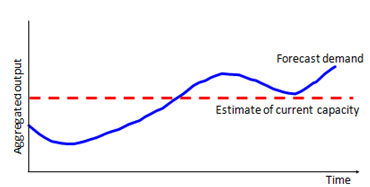
Figure 15: Capacity Management
(Source: Gupta and Wang, 2007).
The figure given above by Gupta and Wang (2007) shows that in order to manage the capacity well, a business needs to measure the total capacity that it can produce by utilizing current resources effectively. Moreover, the demand needs to be measured through various sources and it is required to match the demand with the capacity to deliver higher value to customers. 运营管理
Managing time effectively and eliminating waste activities can lead to better activities being performed along with saving of resources. However, Alp and Tan (2008) stated that the actual demand and the demand forecasted are most likely to differ due to uncertainty.
Uncertainty prevails when consumers are expected to buy the product but they do not due to various factors including lowering income, spending on some other product rather then this product and includes finding a better product to fulfil their need. In addition, buying in bulk in the sale season and stocking it for future usage, buying from some other city or country along with hoarding can also lead to uncertain demand.
On contrast, Xiao and Yang (2008) argued that demand can be uncertain not because of the seasonality but due to the fact that the customer is not satisfied by the products or its price and has decided not to buy the product anymore as he/she has shifted to another brand due to lower switching cost.
译文:图 15:容量管理 运营管理
(来源:Gupta 和 Wang,2007 年)。
上面 Gupta 和 Wang (2007) 给出的数字表明,为了很好地管理产能,企业需要衡量它通过有效利用当前资源可以生产的总产能。此外,需要通过各种来源衡量需求,并且需要将需求与向客户提供更高价值的能力相匹配。
有效地管理时间和消除浪费活动可以在节省资源的同时更好地开展活动。然而,Alp 和 Tan (2008) 指出,由于不确定性,实际需求和预测需求最有可能不同。
当预期消费者购买产品但他们不是由于各种因素(包括降低收入、在其他产品上而不是在此产品上支出)以及包括找到更好的产品来满足他们的需求时,不确定性就会盛行。此外,在销售季节大量购买并备货以备将来使用,从其他城市或国家购买以及囤积也会导致需求不确定。
相比之下,Xiao and Yang (2008) 认为需求的不确定性不是因为季节性,而是因为客户对产品或其价格不满意,并决定不再购买产品,因为他/她由于转换成本较低,已转向另一个品牌。
As indicated by Philips Annual report (2013) the research department of Philips identified that due to aging population
Demand for medical care is growing and due to growing environmental care, the demand for energy efficient lighting is growing due to which the company’s operations are working to manage the capacity to meet the demands in each market well.
The figure below given by Philips Annual report (2013) shows that as a result of matching the capacity to meet demand of well being, 0.29 billion of lives are enhances by Philips well being products, 0.63 billion by Philip care products whereas 1.49 billion lives by Philips green products.
As Philips follows lean manufacturing thus it is essential that it manufacturers and manages its capacity to meet the demand of the market as overproduction does not comply with the lean management principles. Philips (2011) stated that Philips has its own research centres which are working for the analysis of growing needs and demand of consumers.
This is beneficial in order to maintain their capacity to meet the demand. However, as the demand pattern is uncertain, the demand and sales can vary but Philips produces according to the demand as few units not sold cannot cause much harm as that of being out of stock.
The need for improved life was identified by the research centre therefore to meet this demand, the machinery, technology and resources were aligned well to manage capacity.
译文:正如飞利浦年报(2013)所示,飞利浦研究部门发现,由于人口老龄化 运营管理
对医疗保健的需求不断增长,并且由于环保意识的增强,对节能照明的需求也在不断增长,因此公司的运营正在努力管理满足每个市场需求的能力。
飞利浦年报(2013)下图显示,通过匹配满足健康需求的能力,2.9亿人的生活因飞利浦健康产品而改善,6.3亿人因飞利浦护理产品而受益,14.9亿人因飞利浦绿色产品。
由于飞利浦遵循精益制造,因此它必须制造和管理其能力以满足市场需求,因为生产过剩不符合精益管理原则。飞利浦 (2011) 表示,飞利浦拥有自己的研究中心,致力于分析消费者不断增长的需求和需求。
这有利于保持它们满足需求的能力。然而,由于需求模式不确定,需求和销售可能会有所不同,但飞利浦根据需求生产,因为很少的单位未售出不会像缺货那样造成太大的伤害。
研究中心确定了改善生活的需求,因此为了满足这一需求,机器、技术和资源被很好地调整到管理能力。 运营管理
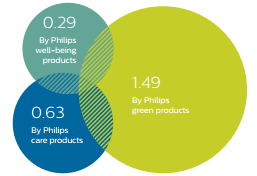
Figure 16: Improved Lives by Philips
(Source: Philips Annual report (2013)
As mentioned by Philips (2015b), the way followed by Philips to manage capacity and demand is that of change demand where the patterns of demand are changed each month due to the demand calculation.
When the demand increases, the capacity is increased temporarily by increase in working hours but this is rare as research of the company works well in measuring demand due to the ample experience along with analyzing demand of each market separately. According to Philips (2011), in order to meet demand effectively and to manage the capacity well,
Philips has few suppliers but the relationship of Philips is strong with all the supply chain partners. Thus, this helps them in meeting uncertain demand in shorter time if needed. Moreover, meeting the growing demand from consumers end, reducing lead cycle, improving the quality of the supplies is easy for Philips due to collaboration with suppliers.
In exchange, the teams of Philips work for the suppliers’ risk management. In 2011 in Japan, the earthquake and tsunami affected the supplies resulted in hoarding which was followed by loss for suppliers. Thus, teams in Japan and elsewhere worked to mitigate these risks for the global market.
This is the reason for suppliers working with Philips in uncertain demand patterns as well. On contrast, Olhager and Johansson (2012) argued that meeting the uncertain demand requires a lot of cost and other resources as latest information and research is required for identifying and calculating the demand and capacity of the business.
译文:图 16:飞利浦改善生活 运营管理
(来源:飞利浦年报(2013)
正如飞利浦 (2015b) 所提到的,飞利浦管理容量和需求所遵循的方式是变化需求,由于需求计算,需求模式每个月都会发生变化。
当需求增加时,由于工作时间的增加,产能会暂时增加,但这种情况很少见,因为公司的研究在衡量需求方面效果很好,因为有丰富的经验,并且分别分析了每个市场的需求。根据飞利浦(2011)的说法,为了有效地满足需求并很好地管理产能,
飞利浦的供应商很少,但飞利浦与所有供应链合作伙伴的关系都很牢固。因此,这有助于他们在需要时在更短的时间内满足不确定的需求。此外,由于与供应商的合作,飞利浦很容易满足消费者不断增长的需求,缩短交货周期,提高耗材质量。
作为交换,飞利浦的团队负责供应商的风险管理。 2011年在日本,地震和海啸影响了供应,导致囤积,供应商流失。因此,日本和其他地方的团队致力于降低全球市场的这些风险。
这也是供应商在不确定的需求模式中与飞利浦合作的原因。相比之下,Olhager 和 Johansson (2012) 认为满足不确定的需求需要大量成本和其他资源,因为需要最新的信息和研究来识别和计算业务的需求和容量。
PART C
Royal Philips is into three businesses namely healthcare, consumer lifestyle, and lighting. The company is well known for its innovation and producing new products according to the needs of the stakeholders. The company has research campuses in China,
India, and Netherlands which are required to identify the needs of consumers and society along with providing concepts of new product development for each of the business of the company. Philips follows a proper business creation process that defines the processes of new product development. Philips uses various software to facilitate in smoothening their operations include SAP and SAVO.
A issue faced by Philips when moving towards e procurement was that of unawareness of employees to use the system therefore this raised the issue of equal training for all employees in each market and for this reason SAVO was included to facilitate equal training and information sharing. The operations manager plays a vital role in managing the operations of Philips along with ensuring efficient use of resources.
The process management at Philips is well maintained as it works in delivering higher value to customers as it involves all the supply chain partners in the process. In addition, the needs are also identified well by the research campus of Philips and customer service strategies are also followed. However, Philips focuses so much on innovation that its focus on customers becomes low and is termed as product centric business.
译文:C部分 运营管理
结论
皇家飞利浦涉足三项业务,即医疗保健、消费者生活方式和照明。该公司以其创新和根据利益相关者的需求生产新产品而闻名。公司在中国设有研究园区,
印度和荷兰需要确定消费者和社会的需求,并为公司的每项业务提供新产品开发的概念。飞利浦遵循定义新产品开发流程的适当业务创建流程。飞利浦使用各种软件来促进其运营顺畅,包括 SAP 和 SAVO。
飞利浦在转向电子采购时面临的一个问题是员工不知道使用该系统,因此这提出了对每个市场的所有员工进行平等培训的问题,因此包括 SAVO 以促进平等培训和信息共享。运营经理在管理飞利浦的运营以及确保资源的有效利用方面发挥着至关重要的作用。
飞利浦的流程管理得到了很好的维护,因为它在流程中涉及所有供应链合作伙伴,因此它致力于为客户提供更高的价值。此外,飞利浦的研究园区也很好地识别了需求,也遵循了客户服务策略。然而,飞利浦非常注重创新,以至于它对客户的关注变得很低,被称为以产品为中心的业务。
译文:飞利浦也是 EFQM 的成员,并在其业务运营中遵循 EFQM 模式进行质量和改进。
飞利浦遵循精益管理,被称为六西格码精益计划。 精益管理改善了运营,同时减少了不确定性和完成流程所用的时间。
为了满足每个市场的需求,容量管理是必不可少的。 飞利浦在研究园区的帮助下很好地管理其产能,这些园区确定了每个季节每个市场的需求。 然而,由于需求是不确定的,因此为了管理这种不确定性变化需求,每个月都会改变需求。
Recommendations
The operation management analysis conducted shows that the operations of Philips are well organized and performing well but few of the recommendations are given that can be followed for improving the operations at Philips. The lean management of Toyota can be followed for flawless operations of Philips.
As mentioned by Lander and Liker (2007) in their research that the lean management of Toyota works on continuous improvement process in each activity. The company works on reducing set up times as set up times are waste of time and resources. Toyota achieves this by organizing procedures and using trained workers along with producing in small lot as bigger lot consumes high time.
This results in short cycle and lead times along with maintaining the quality of work and product. In addition, suppliers are involved and trained to reduce inventory, set up time and to maintain higher quality.
Moreover, employees are empowered and involved in decision making and all aspects of the business as it trains them to correct the error then and there where they see it. Furthermore, this employee involvement also helps in increasing the morale of the employees.
译文:建议 运营管理
所进行的运营管理分析表明,飞利浦的运营组织良好,表现良好,但提出的改进飞利浦运营的建议很少。飞利浦的完美运营可以遵循丰田的精益管理。
正如 Lander 和 Liker (2007) 在他们的研究中提到的,丰田的精益管理致力于在每项活动中持续改进过程。该公司致力于减少设置时间,因为设置时间是浪费时间和资源。丰田通过组织程序和使用训练有素的工人以及小批量生产来实现这一目标,因为大批量需要大量时间。
这样可以缩短周期和交货时间,同时保持工作和产品的质量。此外,供应商参与并接受培训以减少库存、设置时间和保持更高的质量。
此外,员工被授权并参与决策和业务的所有方面,因为它训练他们在他们看到的地方纠正错误。此外,这种员工参与也有助于提高员工的士气。
Philips is focusing less of quality and on employees therefore Philips should work on their employees
Involve them and should employ strategic human resources practices to work through them. According to Carvalho, Azevedo and Cruz-Machado (2010), in operations management, wastages are to be reduced and avoided; visual controls should be developed along with maintaining high quality standards for production and other functions.
As smooth and effective operations are achievable only by the employees therefore SMART objectives for the operations of Philips should be set and employees should be incentivized through monetary and non monetary benefits for the achievement of those objectives. Workload should be level out along with employing pull strategy in order to avoid overproduction.
Sousa and Voss (2008) stated that in order to manage operations of a business well, a culture should be built that aims at achieving quality for the first time instead of correcting them each time. In addition, if any issue is being faced, then the root cause of the issue is to be identified in order to finish that issue completely. As mentioned by Skerlavaj,
译文:飞利浦对质量和员工的关注较少,因此飞利浦应该为他们的员工工作 运营管理
让他们参与进来,并应采用战略人力资源实践来解决这些问题。根据 Carvalho、Azevedo 和 Cruz-Machado (2010) 的说法,在运营管理中,应减少和避免浪费;应开发视觉控制,同时保持生产和其他功能的高质量标准。
由于只有员工才能实现平稳有效的运营,因此应为飞利浦的运营设定 SMART 目标,并应通过货币和非货币福利激励员工实现这些目标。工作量应该在采用拉动策略的同时保持平衡,以避免生产过剩。
Sousa 和 Voss (2008) 指出,为了更好地管理企业的运营,应该建立一种文化,旨在第一次达到质量,而不是每次都纠正它们。此外,如果遇到任何问题,则应确定问题的根本原因,以彻底解决该问题。正如 Skerlavaj 所提到的,
Stemberger, Skrinjar and Dimovski (2007),
To achieve excellence in operations, the organization should be converted to a Learning organization where employees not only learn by research and development campuses but also on their own and by other stakeholders. Job rotation should be employed to recognize the issues and to understand the situation of each activity.
Decisions regarding operations of Philips should be made by consensus rather than the black belt master taking the decision on its own without consulting others.
Hodge, Goforth Ross, Joines and Thoney (2011) recommended that in operations of a manufacturing firm, the errors identified should be witnessed personally in order to understand the level of error instead of relying on words of others.
The effective implementation of lean manufacturing results in lowering cost, this benefit should also be transferred to the customers in order to deliver higher value to them. The time between the order placed of Philips product and the time taken to deliver it is to be reduced and to be measured in hours rather than days as this will help in reducing the lead times and providing just in time inventory.
译文:Stemberger、Skrinjar 和 Dimovski (2007) 运营管理
为了实现卓越的运营,组织应该转变为学习型组织,员工不仅可以通过研发园区学习,还可以自己和其他利益相关者学习。应采用工作轮换来识别问题并了解每项活动的情况。
有关飞利浦运营的决策应以协商一致方式做出,而不是黑带大师在未咨询他人的情况下自行做出决定。
Hodge、Goforth Ross、Joines 和 Thoney (2011) 建议在制造公司的运营中,应亲自见证识别出的错误,以了解错误的程度,而不是依赖他人的话。
精益制造的有效实施可以降低成本,这种好处也应该转移给客户,以便为他们提供更高的价值。飞利浦产品下订单和交付时间之间的时间将减少,并以小时而不是天来衡量,因为这将有助于缩短交货时间并提供及时的库存。
References
Alp, O., and Tan, T. (2008). Tactical capacity management under capacity flexibility. IIE Transactions, 40(3), 221-237.
Antony, J. (2006). Six sigma for service processes. Business Process Management Journal, 12(2), 234-248.
Archel, P., Fernández, M., and Larrinaga, C. (2008). The organizational and operational boundaries of triple bottom line reporting: a survey. Environmental Management, 41(1), 106-117.
Arnaboldi, M., and Spiller, N. (2011). Actor-network theory and stakeholder collaboration: The case of cultural districts. Tourism Management, 32(3), 641-654. 运营管理
Brown, S., Bessant, J. and Lamming, R. (2013).
Strategic Operations Management (3rd Edition). Routledge: Oxon.
Büchel, B., Nieminen, L., Armbruster-Domeyer, H., and Denison, D. (2013). Managing stakeholders in team-based innovation: The dynamics of knowledge and trust networks. European Journal of Innovation Management, 16(1), 22-49.
Bush, S. (2011). Colour rendering from LED lighting [Online]. Available at <http://www.electronicsweekly.com/news/components/led-lighting/colour-rendering-from-led-lighting-2011-08/> [Accessed on 13th January 2015]
Carvalho, H., Azevedo, S. G., and Cruz-Machado, V. (2010). Supply chain performance management: lean and green paradigms. International Journal of Business Performance and Supply Chain Modelling, 2(3), 304-333.
Dadzie, K. Q., and Winston, E. (2007).
Consumer response to stock-out in the online supply chain. International Journal of Physical Distribution & Logistics Management, 37(1), 19-42.
Denning, S. (2011). The "Relative NPS" Trap: Why Philips Isn't Delighting Its Customers [Online]. Available at < http://www.forbes.com/sites/stevedenning/2011/11/02/the-relative-nps-trap-why-philips-isnt-delighting-its-customers/> [Accessed on 14th January 2015]
Dugmore, J. (2006). Capacity Management (1st Edition). BSI British Standards Institution: UK
Ede, J. (2009). Lean Six Sigma boosts value creation within Philips Consumer Lifestyle [Online]. Available at <http://www.business-improvement.eu/six_sigma/Simply_Philips_Lean_Six_Sigma_eng.php> [Accessed on 14th January 2015]
Ede, J. (2010). Simply Philips pursues optimal balance in applying Lean and Six Sigma [Online]. Available at <http://www.business-improvement.eu/six_sigma/Simply_Philips_Lean_Six_Sigma_eng.php> [Accessed on 14th January 2015]
EFQM (2015). EFQM Model [Online]. Available at <http://www.efqm.org/efqm-model/model-criteria> [Accessed on 14th January 2015]运营管理
Emiliani, M. L. (2006).
Origins of lean management in America: the role of Connecticut businesses. Journal of management History, 12(2), 167-184.
Fineberg, S. (2014). Philips Continues B2B Rebranding Push with Digital Stories [Online]. Available at <http://adage.com/article/btob/philips-continues-b2b-rebranding-push-digital-stories/292210/> [Accessed on 13th January 2015]
Ford, A. L., Williams, J. A., Spencer, M., McCammon, C., Khoury, N., Sampson, T. R. and Lee, J. M. (2012). Reducing door-to-needle times using Toyota’s lean manufacturing principles and value stream analysis. Stroke,43(12), 3395-3398.
Furterer, S. L. (2009). Lean Six Sigma in service: applications and case studies. CRC Press: US.
Ghijsen, P. W. T., Semeijn, J., and Ernstson, S. (2010). Supplier satisfaction and commitment: The role of influence strategies and supplier development. Journal of Purchasing and Supply Management, 16(1), 17-26.
Goodwin, B. (2000). Philips adopts e-procurement in bid to cut costs [Online]. Available at <http://www.computerweekly.com/news/2240040420/Philips-adopts-e-procurement-in-bid-to-cut-costs> [Accessed on 13th January 2015]
Gupta, D., and Wang, L. (2007).
Capacity management for contract manufacturing. Operations Research, 55(2), 367-377.
Hodge, G. L., Goforth Ross, K., Joines, J. A.,and Thoney, K. (2011). Adapting lean manufacturing principles to the textile industry. Production Planning & Control, 22(3), 237-247.
Karsten, L., Keulen, S., Kroeze, R., and Peters, R. (2009). Leadership style and entrepreneurial change: The Centurion operation at Philips Electronics. Journal of Organizational Change Management, 22(1), 73-91.
Lamb, C., Hair, J. and McDaniel, C. (2008). Marketing (10th Edition). Cengage Learning: Mason. 运营管理
Lander, E., and Liker, J. K. (2007).
The Toyota Production System and art: making highly customized and creative products the Toyota way. International Journal of Production Research, 45(16), 3681-3698.
Langabeer, J. (2008). Health Care Operations Management: A Quantitative Approach to Business and Logistics. Jones & Bartlett Learning: Canada.
Longoni, A., Golini, R., and Cagliano, R. (2014). The role of New Forms of Work Organization in developing sustainability strategies in operations. International Journal of Production Economics, 147, 147-160.
Madison, D. (2005).
Process Mapping, Process Improvement, and Process Management: A Practical Guide for Enhancing Work and Information Flow (2nd Edition). Paton Professional.
Mil, W. (2010). From Lean Product Development towards Lean Innovation- Experiences within Philips Electronics [Online]. Available at < http://www.innovationservices.philips.com/sites/default/files/philips_webinar_-from_lpd_to_li-wmil-20100928-_final.pdf> [Accessed on 14th January 2015]
Mishra, A. A., and Shah, R. (2009). In union lies strength: Collaborative competence in new product development and its performance effects. Journal of Operations Management, 27(4), 324-338.
Nair, A., Narasimhan, R., and Bendoly, E. (2011).
Coopetitive buyer–supplier relationship: an investigation of bargaining power, relational context, and investment strategies. Decision Sciences, 42(1), 93-127.
Olhager, J., and Johansson, P. (2012). Linking long-term capacity management for manufacturing and service operations. Journal of engineering and technology management, 29(1), 22-33.
Philips (2011). Supply management [Online]. Available at <http://www.annualreport2011.philips.com/content_ar-2011/en/group_performance/supply_management.aspx#section3> [Accessed on 13th January 2015]
Philips (2013). Operational Risks [Online]. Available at<http://www.annualreport2013.philips.com/content/en/risk_management/operational_risks.html> [Accessed on 13th January 2015]
Philips (2015a). Company Profile [Online].
Available at < http://www.philips.com/about/company/companyprofile.page> [Accessed on 13th January 2015]
Philips (2015b). About Philips Procurement [Online]. Available at < http://www.philips.com/about/company/businesses/suppliers/index.page> [Accessed on 13th January 2015]
Philips (2015c). Quality and Business Excellence [Online]. Available at <http://www.philips.com/about/company/businesses/businessesexcellence.page> [Accessed on 14th January 2015]
Philips (2015d). Xper Inventory Coordinator [Online]. Available at <http://www.healthcare.philips.com/main/products/healthcare_informatics/xper_info_mgt/inventory.wpd> [Accessed on 14th January 2015]
Philips Annual report (2013). Philips Annual report 2013 [Online]. Available at < file:///C:/Users/User/Downloads/PhilipsFullAnnualReport2013_English.pdf> [Accessed on 13th January 2015]运营管理
Philips Research (2015).
Meet Philips Research [Online]. Available at <http://www.research.philips.com/> [Accessed on 13th January 2015]
SAP (2013). Philips Respironics GK: Helping Customers Breathe Easier with the SAP® CRM Rapid-Deployment Solution [Online]. Available at <http://www.sap.com/bin/sapcom/cs_cz/downloadasset.2013-03-mar-14-09.philips-respironics-pdf.html> [Accessed on 13th January 2015]
SAVO Group (2012). CASE STUDY: Philips Healthcare [Online]. Available at < http://www.savogroup.com/assets/2012/04/CS_Philips_SEO.pdf> [Accessed on 13th January 2015]
Scheine, W. (2013). Philips Outside-in approach in product development: Lighting for electrical cars [Online]. Available at <http://www.holland-innovative.nl/images/automotive/Philips_-_Wolfgang_Schiene> [Accessed on 13th January 2015]
Schroeder, R. G., Linderman, K., Liedtke, C., and Choo, A. S. (2008). Six Sigma: definition and underlying theory. Journal of operations Management, 26(4), 536-554.
Skerlavaj, M., Stemberger, M. I., Skrinjar, R., and Dimovski, V. (2007). Organizational learning culture—the missing link between business process change and organizational performance. International Journal of Production Economics, 106(2), 346-367.
Sousa, R., and Voss, C. A. (2008).
Contingency research in operations management practices. Journal of Operations Management, 26(6), 697-713.运营管理
Stevenson, W. J., and Hojati, M. (2007). Operations management (Vol. 8). McGraw-Hill/Irwin: Boston.
Stock, R. M., and Zacharias, N. A. (2011). Patterns and performance outcomes of innovation orientation. Journal of the Academy of Marketing Science, 39(6), 870-888.
Xiao, T., and Yang, D. (2008). Price and service competition of supply chains with risk-averse retailers under demand uncertainty. International Journal of Production Economics, 114(1), 187-200.
Yang, H. M., Choi, B. S., Park, H. J., Suh, M. S., and Chae, B. K. (2007). Supply chain management six sigma: a management innovation methodology at the Samsung Group. Supply Chain Management: An International Journal, 12(2), 88-95.
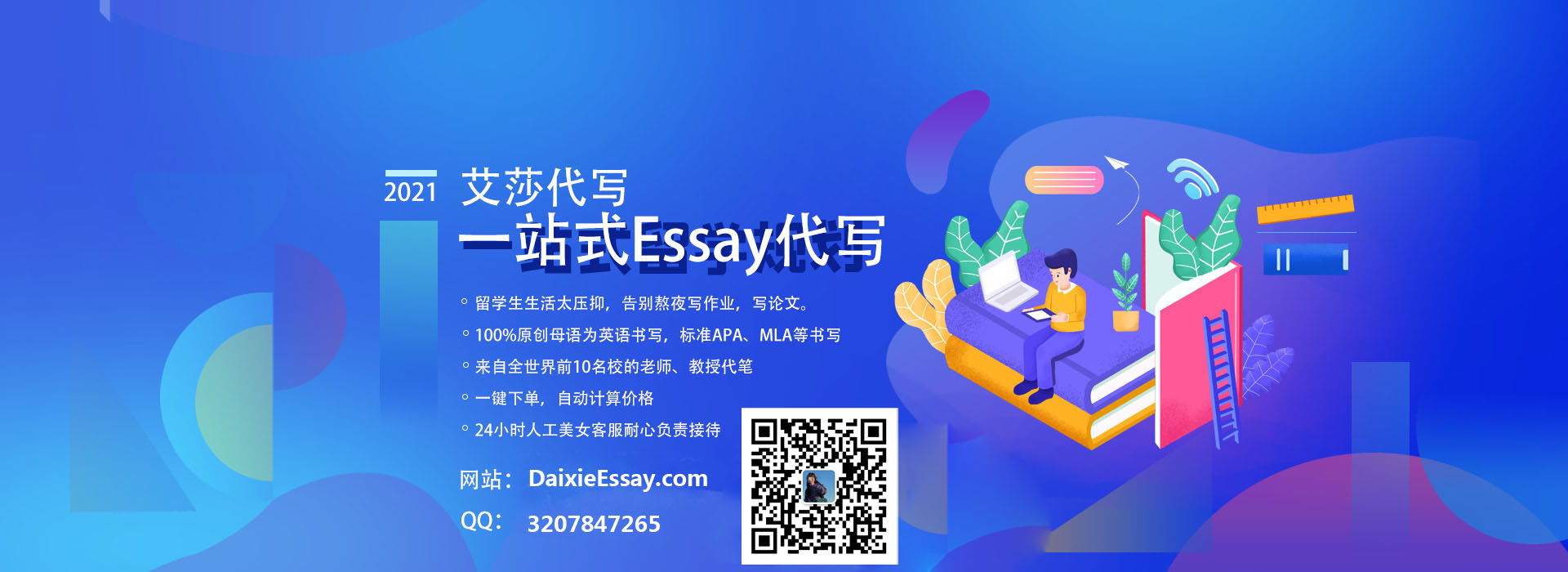




发表回复
要发表评论,您必须先登录。